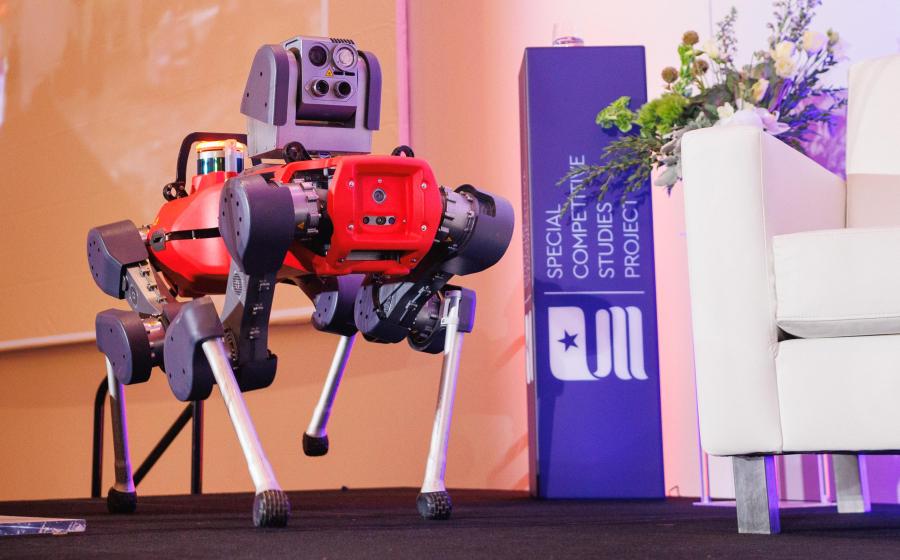What to Know Now About AI and Robotics
(NewsUSA) - The United States is poised for global leadership in the area of AI and robotics as discussed at the AI+ Robotics Summit hosted by the Special Competitive Studies Project (SCSP), a nonprofit and nonpartisan initiative with a goal of making recommendations to strengthen America's long-term competitiveness in AI. The sessions highlighted significant technological advancements and outlined ways to achieve and maintain global leadership, said SCSP in a recent newsletter.
- The United States is poised for global leadership in the area of AI and robotics as discussed at the AI+ Robotics Summit hosted by the Special Competitive Studies Project (SCSP), a nonprofit and nonpartisan initiative with a goal of making recommendations to strengthen America's long-term competitiveness in AI. The sessions highlighted significant technological advancements and outlined ways to achieve and maintain global leadership, said SCSP in a recent newsletter.
Key takeaways regarding AI and robotics identified at the summit include:
- Advances in AI have enabled robotics to move from physics-based problems to natural language solutions. The next generation of robots will be powered in part by LLMs, simulation computers, and on-device robotic foundation models.
- Using AI in simulation environments to model robot interactions at machine scale. Gathering simulation and real-world data would allow robots to expand beyond factories and warehouses.
- Future factories will be highly automated due to advanced manufacturing. Factories are the testing ground for innovation in AI-enabled robotics. These advances will also support a transformation across industries ranging from agriculture to medicine to construction.
- Brainstorming “moonshot” ideas. Players from all parts of the U.S. robotics ecosystem could get behind big ideas that would fuel the U.S. robotics ecosystem to technological advantage, such as investing in robotics supply chains and leveraging AI-enabled robots to search for life in outer space.
- Taking advantage of voluntary public-private partnerships. Today’s AI and robotics innovations are driven by the private sector, but partnerships can help bridge technology gaps, strengthen supply chains, and address workforce challenges.
- Promoting private investment in hardware. The U.S. government can reduce the risk for private investment in robotics production at scale with incentives such as tax credits.
- Embracing new jobs. Placing AI at the center of learning will educate the next generation workforce with new skills to adapt to an evolving technology landscape.
- Accelerating learning, mapping, and cooperating on robotics with allies. The U.S. should work with partner nations to foster structural cooperation on shared programs.
- Catching up to China’s industrial robotics. China has aggressively adopted new technologies for robotics in manufacturing. These investments and initiatives pose a competitive challenge to the U.S.
- Bringing robotics to the forefront of U.S. technology strategies. China has outcompeted the U.S. in robotics and the lack of a national strategy illustrates how it is a secondary consideration.
Visit scsp.ai to learn more, and visit the SCSP YouTube channel to watch sessions from the AI+ Robotics Summit.



 - Seattle, WA – iLocal, Inc., a leader in website development and search engine optimization (SEO), announces its latest suite of services designed to help businesses maximize online visibility, increase customer engagement, and drive measurable growth. Known for its innovative digital solutions, iLocal, Inc. combines a personalized approach with industry-leading technology to deliver high-quality, fully optimized websites that rank well in search results and convert visitors into loyal customers.
- Seattle, WA – iLocal, Inc., a leader in website development and search engine optimization (SEO), announces its latest suite of services designed to help businesses maximize online visibility, increase customer engagement, and drive measurable growth. Known for its innovative digital solutions, iLocal, Inc. combines a personalized approach with industry-leading technology to deliver high-quality, fully optimized websites that rank well in search results and convert visitors into loyal customers. -
-  Three key areas of technology – internet platforms, advanced battery technologies, and next-gen networks – have shown shifts in positions of power between the United States and China in the last few years, according to
Three key areas of technology – internet platforms, advanced battery technologies, and next-gen networks – have shown shifts in positions of power between the United States and China in the last few years, according to 
 - Artificial intelligence (AI) creates many things, including
- Artificial intelligence (AI) creates many things, including 
 - As advances in artificial intelligence continue to transform the world, the integration of AI and robotics will have a significant impact on many areas, and will change both fields.
- As advances in artificial intelligence continue to transform the world, the integration of AI and robotics will have a significant impact on many areas, and will change both fields. 
 - As artificial intelligence technology grows stronger, what we known about the complexity of the human brain provides perspective to its development, according to experts at experts at the Special Competitive Studies Project (SCSP), a nonprofit and nonpartisan initiative with a goal of making recommendations to strengthen America's long-term competitiveness in AI.
- As artificial intelligence technology grows stronger, what we known about the complexity of the human brain provides perspective to its development, according to experts at experts at the Special Competitive Studies Project (SCSP), a nonprofit and nonpartisan initiative with a goal of making recommendations to strengthen America's long-term competitiveness in AI.
 - The United States leads the world in artificial intelligence (AI), but this edge is at risk without a solution to the energy crisis caused by data centers that power AI, onshore manufacturing, and rapid electrification
- The United States leads the world in artificial intelligence (AI), but this edge is at risk without a solution to the energy crisis caused by data centers that power AI, onshore manufacturing, and rapid electrification 
 - The U.S. economy remains dynamic and robust, but continued focus on advanced manufacturing is needed to cement U.S. leadership in industries of the future, according to experts at the
- The U.S. economy remains dynamic and robust, but continued focus on advanced manufacturing is needed to cement U.S. leadership in industries of the future, according to experts at the 
 - Threats to global stability continue to evolve to include greater use of artificial intelligence (AI) to promote disinformation, according to experts at the
- Threats to global stability continue to evolve to include greater use of artificial intelligence (AI) to promote disinformation, according to experts at the 

 - Artificial intelligence (AI) continues to transform the United States and the world. To promote and inform rapid advancements in AI and maintain America’s global competitiveness, the
- Artificial intelligence (AI) continues to transform the United States and the world. To promote and inform rapid advancements in AI and maintain America’s global competitiveness, the 


